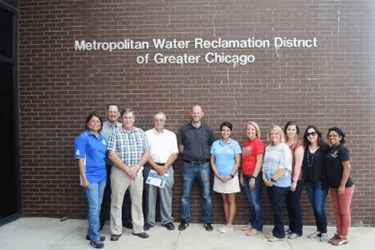State Representative Tabares, Illinois Farm Bureau Tour MWRD's Stickney Water Reclamation Plant

Illinois State Representative Silvana Tabares, 21st Legislative District, and members of the Illinois Farm Bureau recently toured the Metropolitan Water Reclamation District of Greater Chicago's (MWRD's) Stickney Water Reclamation Plant, the world's largest wastewater treatment facility. The Stickney WRP cleans on average 700 million gallons of water per day with the capacity to treat up to 1.44 billion gallons per day.
During the Aug. 11 tour, the group saw firsthand the impact of two legislative initiatives that Rep. Tabares and other members of the Illinois General Assembly supported: one item allowed the MWRD to produce exceptional quality (EQ) biosolids for use as a natural alternative to fertilizer; the other initiative supported MWRD's phosphorous recovery facility which was made possible in part by the MWRD Resource Recovery legislation that was signed into law last year.
Biosolids are the nutrient-rich, organic material developed through the extensive wastewater treatment process. They are a superior, yet less expensive alternative to chemical fertilizers that are used in landscaping and for fertilizing turf grass at parks and athletic fields and row crops in farmers' fields.
Chicagoland soil can be too compacted for good root development, and it can lack the vital nutrients and organic matter that plants need to thrive. Heavy summer rains can wash fertilizers away, and long dry spells can leave grass parched. Using biosolids can help create a beautiful landscape. In the meantime, excess phosphorus enters bodies of water from a number of sources, including urban water treatment facilities and farm run-off. Phosphorus in waterways can cause algae to grow and bloom, creating toxic conditions that threaten aquatic life and severely limit recreational enjoyment of lakes and rivers. The Illinois Farm Bureau was specifically interested in the MWRD's water treatment process as its members are also looking at how to address water treatment and runoff issues on agricultural land.
"Thanks to Rep. Tabares and the Illinois General Assembly, the District was allowed to construct the world's largest phosphorus recovery facility which opened earlier this year," said MWRD Commissioner David J. Walsh.
"I'd like to thank the hard working men and women of the Water Reclamation District's Stickney plant for welcoming myself and visitors with the Illinois Farm Bureau during our recent tour of the facility," said Rep. Tabares. "The work of the water reclamation district is vitally important to the region's residents and the overall environment, and seeing the important work first-hand was a great experience for myself as well as for our visitors from Central Illinois."
"We are always appreciative whenever our legislative leaders take time out of their busy schedules to tour our processes and facilities," said MWRD President Mariyana Spyropoulos. "It was the Illinois General Assembly that created the District in 1889 so it is important that we continue to engage in operations as the legislature intended."
Rep. Tabares is serving her second term, and her district includes portions of Bedford Park, Cicero, Forest View, Lyons, McCook, Riverside, Stickney and Summit, and the Chicago neighborhoods of Archer Heights, Brighton Park, Garfield Ridge, Lower West Side, McKinley Park and South Lawndale.
About The Metropolitan Water Reclamation District of Greater Chicago
Established in 1889, the MWRD is an award-winning, special purpose government agency responsible for wastewater treatment and stormwater management in Cook County, Illinois. For more information, visit www.mwrd.org.
Source: The Metropolitan Water Reclamation District of Greater Chicago's (MWRD's)
